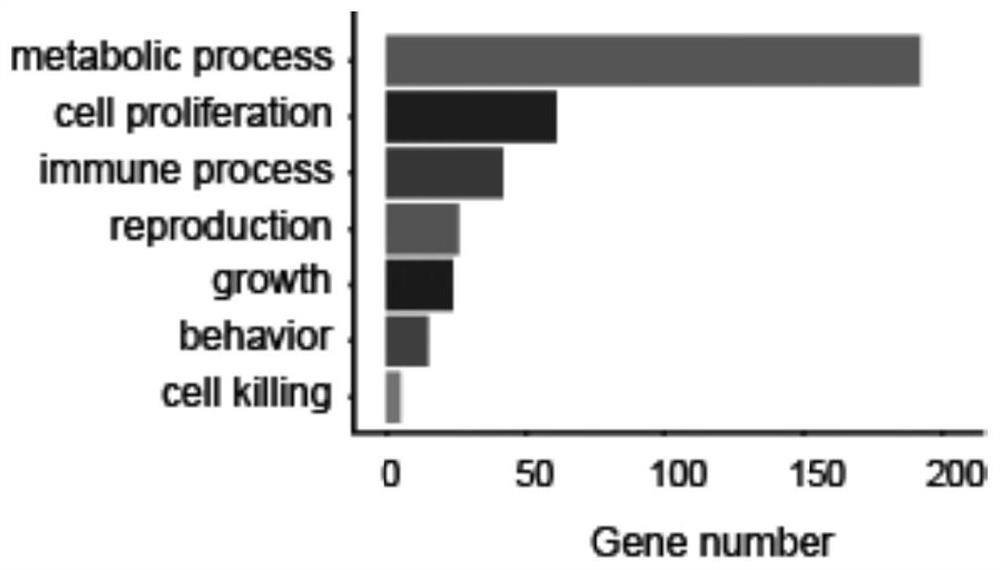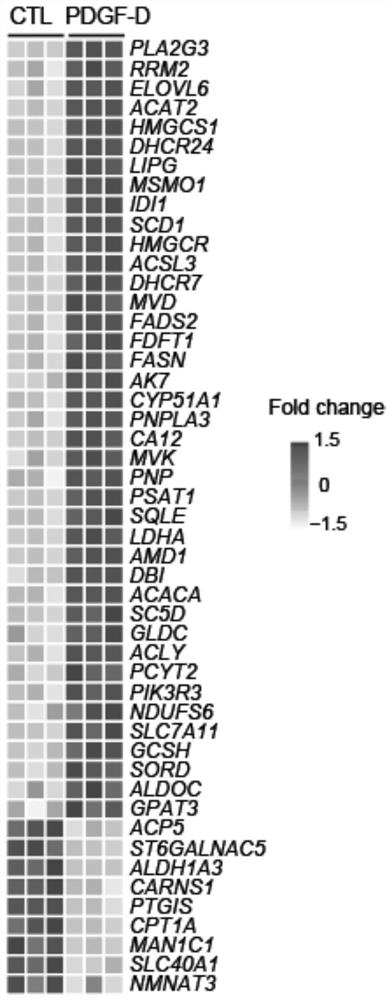Method and preparation for regulating lipid secretion of retinal pigment epithelial cells and application thereof
A technology of retinal pigment and epithelial cells, applied in the field of regulating lipid secretion of retinal pigment epithelial cells, can solve problems such as lack of intervention in early AMD
- Summary
- Abstract
- Description
- Claims
- Application Information
AI Technical Summary
Problems solved by technology
Method used
Image
Examples
Embodiment 1
[0046] 1. Perform transcriptomic analysis to determine differentially expressed gene profiles
[0047] a. RNA sequencing: Human retinal pigment epithelial cells (HRPE, Sciencell,) were cultured to 80%-90% confluence, starved for 12 hours with serum-free medium, and then treated with 50ng / ml human recombinant PDGF-D protein (R&D, 1159- SB-025 / CF) were treated for 18 hours, and RNA was extracted for transcriptome sequencing.
[0048] b. Transcriptomic analysis: 2 μg of total RNA from each sample was used to make an Illumina cDNA library, sequenced on the Illumina HiSeqX-Ten, and the total number of reads (reads) compared to the genome for each sample was between 39 million and 50 million between. Reads were aligned to transcriptome files using TopHat2 and aligned reads were counted for each transcript using Cuffquant. . Differentially expressed genes were determined using DESeq2 (v1.22.2) software. Fold changes were determined from the FPKM of each sample. Differentially ex...
Embodiment 2
[0058] 1. Experimental construction method:
[0059] (1) Construct PDGF-D tissue-specific overexpression mouse model and observe pathological sections
[0060] a. Construct the adeno-associated virus (AAV) of RPE-specific overexpression: Utilize human VMD2 gene transcription initiation site upstream -598bp to +378bp sequence as retinal pigment epithelial cell (RPE) specific promoter, and utilize PDGF- The coding sequence of the D gene (NM_025208) was used as the target fragment to construct the vector and packaged into serotype 8 AAV. Store at -80°C.
[0061] b. Subretinal injection of AAV in mice: topical application of tropicamide for mydriasis, intraperitoneal injection of 4% chloral hydrate (10ml / kg body weight) for anesthesia, and then dripping procainamide for surface anesthesia of the cornea, and using Sodium carboxymethylcellulose prevents corneal desiccation. For subretinal injection, a sterile 5 μl syringe (Hamilton, CAT: 7633-01), 33-gauge needle (Hamilton, CAT: ...
Embodiment 3
[0072] 1. Construct a high-fat diet model (HLD) to simulate early AMD and evaluate the therapeutic potential of targeting PDGF-D, SREBP1, and SCD1
[0073] a. Constructing a high-fat diet model: 12-month-old mice were selected and given a normal diet and a high-fat diet with 4 times the fat content for 1 month.
[0074] b. Detect the expression levels of PDGF-D and lipid synthesis genes in HLD mice: collect normal and HLD mouse eyeballs, separate the retina and choroid, extract RNA according to the method in 2) a, and perform qPCR to detect the expression levels of related genes.
[0075] c. Evaluate the therapeutic potential of targeting PDGF-D on subretinal deposition induced by high-fat diet: while constructing the HLD model, inject PDGF-D antibody CR002 or ShRNA into the mouse vitreous cavity, once a week, a total of 4 times. The mouse eyeballs were taken for paraffin sections and H&E staining, and the number of subretinal deposits in the injected antibody or shRNA and the c...
PUM
 Login to View More
Login to View More Abstract
Description
Claims
Application Information
 Login to View More
Login to View More - R&D
- Intellectual Property
- Life Sciences
- Materials
- Tech Scout
- Unparalleled Data Quality
- Higher Quality Content
- 60% Fewer Hallucinations
Browse by: Latest US Patents, China's latest patents, Technical Efficacy Thesaurus, Application Domain, Technology Topic, Popular Technical Reports.
© 2025 PatSnap. All rights reserved.Legal|Privacy policy|Modern Slavery Act Transparency Statement|Sitemap|About US| Contact US: help@patsnap.com



